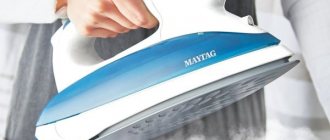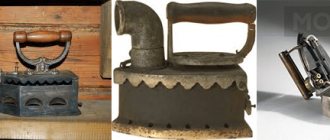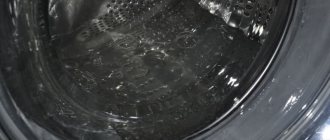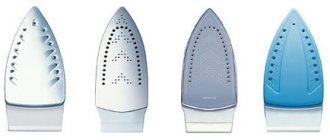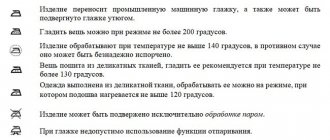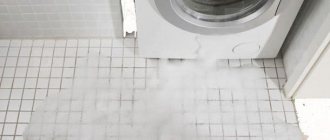Almost every iron model has a mode for steaming clothes when ironing. With its help you can smooth out even the most severe creases. The housewife, using a device equipped with a steam jet, can easily and quickly deal with laundry deposits.
But then we lift the iron and a stream of water flows from it. How to overcome this problem? What are the reasons for such breakdowns? How to repair the problem? This will be discussed in this article.
Water leaks from the iron during ironing: what is the problem?
To understand the reason, it is necessary to study the mechanism of operation of the device. The iron has a container into which cold water is poured before ironing. Next, the desired temperature is set and the air flow mode is turned on. A small amount of liquid is supplied to the chamber, where, after pressing a button on the handle of the device, pressure is created. Hot, moist steam begins to flow from the holes in the sole.
But it happens that water flows out instead of air. What does this come from:
- valve failure;
- failure of working parts due to the user’s failure to comply with the operating instructions.
When it is clear why water is leaking from the iron, it will be possible to take action. Some problems can be solved on our own.
How does the steam supply work?
When trying to find out the cause of water leaking from an iron, it is important to first understand how the formation and supply of steam in this household appliance works. First, water is poured through the neck into a special tank. From here, during steaming, water is supplied to the sole through a special control valve, which, depending on the temperature of the sole, regulates the water pressure. Once on the heated sole, the liquid under the influence of high temperature turns into steam, which is supplied through holes in the sole to the fabric being steamed.
Important! To avoid the rapid appearance of scale in household irons and steam generators and their premature failure, it is recommended to use distilled water.
Knowing now the algorithm for generating steam in the iron, you can try to understand what problems may arise here, due to which water may begin to flow uncontrollably from the sole of the iron during ironing.
Most common reasons
Each device eventually begins to cause some trouble. Even when used correctly, small or large damage occurs. Why water flows out of the iron in a horizontal position, there are several most common reasons:
- The valve is broken. After ironing, all the water may not be used up, but the water should not run into the sole. The passage is blocked by a special valve. But this element may wear out and not do its full job, and then water begins to flow from the iron. This fault can be easily checked. Turn off the device and shake vigorously for 15–20 seconds, holding it horizontally. If water begins to pour out, then it is necessary to change the valve or gaskets. Rubber deteriorates when exposed to hot liquid, and through holes form in it. As a result, the expected air flow in the holes turns into water droplets. Moreover, you can do the work yourself without contacting a service center.
The base temperature of the device is low. Steaming must be carried out strictly according to the instructions. Housewives encounter this problem when they start ironing things before the iron heats up to the desired setting. The water will not turn into steam, but will begin to pour out of the holes. The lid of the tank must be closed well, otherwise the liquid will also begin to seep out.- Scale formation. The iron can also leak due to the formation of a limescale layer in the passages, which slows down the heating of the sole. This problem causes liquid droplets to come out of the holes.
- Condensation accumulates on the surface of the base of the device while all elements are cooling. When you turn on the iron and start working, drops will come out with the first steam. There will be wet marks on the laundry.
- The heating element is broken. This is easy to understand; the bottom of the device will be slightly warm or even cold. Ten will have to be changed.
Common causes of water leaking from an iron
Water may leak from the iron if the valve of the device is broken or the device is used incorrectly.
Broken valve
Water from the water tank is supplied to the inner surface of the sole. A steam regulator is built into the housing. They can be used to regulate the intensity of the steam jet. When the device heats up, the water turns into steam and steams unironed folds in the laundry.
If there is still water in the tank and the iron has cooled down, then it may leak when the valve is closed. The cause of the leak is a broken valve.
The malfunction should be checked as follows: turn off the steam supply and, without turning on the iron, shake it, placing it in a horizontal state. If water flows out, it means the valve does not regulate the flow of steam into the soleplate of the iron. Often the malfunction lies in wear and loss of elasticity of the rubber valve gasket.
Incorrect operation
After turning on the device, if the iron has not heated up to the optimal temperature, then steam has not yet formed and water begins to leak through the holes, which the valve has “distilled” into the steam chamber.
How to avoid water leaking out of the iron during operation?
To avoid liquid leaking out of the holes on the soleplate, you should wait until the iron warms up each time.
This is done correctly like this: turn on the steam mode, set the desired temperature, turn the iron vertically, wait until the heating indicator turns off and begin ironing things.
The water filling hole must be closed after filling the tank. This way, drops will not get on the fabric and will not leave wet spots.
What to do when water flows from the iron
The iron needs to be descaled from time to time. This procedure is easy to carry out at home.
Method 1
- Dissolve citric acid powder in water;
- Pour the solution into the reservoir;
- Set the iron to maximum temperature;
- We wait until the indicator goes out;
- Lightly shake the device and add water to the steam chamber;
- Repeat until completely clean.
What will happen? Water touches the hot heating element. In this case, the hot and cold surfaces come into contact, adding exposure to an acidic environment. The scale lags behind the walls and comes out through the holes in the sole of the iron. In the same way, you can wash away any debris that has gotten into the sole of the device.
Method 2
Many appliance models have a special rod for collecting scale. From time to time it should be cleaned by placing it in a solution of citric and acetic acid for a couple of hours. After cleaning, the rod is rinsed under running water and reinserted into the device.
The first ironing after cleaning should be on an unnecessary piece of fabric. Limescale and debris will remain on the fabric.
If cleaning the iron does not help, then you should contact repair specialists at the service center. There, they will be able to diagnose the problem and fix it.
Ways to fix the problem
- Cleaning the iron yourself;
- Repair in a service workshop;
- Do-it-yourself repair (if the owner has the necessary skills).
How to fix a leak: several options
In case of serious damage, you need to contact a specialist, but some problems can be corrected yourself. Tap water is poured into the iron's reservoir, and it contains many different impurities that fall as precipitation on the walls of the device. Therefore, it must be regularly cleaned of plaque. There are two effective ways to deal with the problem.
First option
Citric acid (10 g) is added to the water that is poured into the container of the device. Then, after filling the iron with water, turn it on at full power. You should wait a while until the indicator light goes off. Shake the liquid in the container a little, and then press the steam button, the water will fall into the chamber. The procedure must be repeated until the scale is completely removed. Usually, irons that have not had preventative maintenance for a long time are cleaned several times.
Why do this cleaning? A cold solution of an acidic medium falls on the hot heating element. A reaction occurs that separates scale from the surface. All debris comes out through the steam holes. You can also remove various debris from the tank.
Second option
Many models of steam electric appliances have a rod that collects plaque. It must be removed regularly to remove scale. The rod is left for several hours in water with added vinegar and citric acid in equal parts, 10 ml each. Then the element is washed in clean water and inserted into place. After this procedure, first iron the unnecessary fabric so that the remaining scale and debris come out with evaporation.
We recommend:
What kind of water is required for an iron
Important! After ironing, the iron must be turned off and placed in a vertical position. All liquid must be drained. If you perform these procedures regularly, you will not have to deal with the problem of iron leakage for a long time.
Mistakes when using an iron, preventive measures
The main reason why water pours out of a steam iron is a simple failure to follow the operating instructions for the device. The iron has all the designations of modes and temperatures on the body. The regulator shows when to use the steam boost. The device must first be heated to a temperature where steam can form. Otherwise, drops of liquid will begin to come out of the holes on the sole instead.
Before setting the steam mode, you need to set the regulator arrow to the type of fabric. The iron should be heated vertically until the light indicating readiness for work goes out. How to fix the problem when the iron drips, many owners think. But if the temperature-regulating element stops working, you need to seek help from specialists in the workshop. Repairing will help you save on costs as it will be cheaper than buying a new appliance.
Broken valve
Cause of malfunction
If, following the operating rules, water leaks out of the iron, then the cause of the breakdown is most likely a broken valve that regulates the water supply. To check whether this is so, you need to pour water into the iron, turn off the steam mode and, without plugging the device into the outlet, shake and shake it slightly. If liquid flows from the sole, then we can safely say that the control valve has failed.
The reason lies in the fact that this valve is equipped with rubber gaskets, which, with prolonged exposure to high temperatures, become less flexible and begin to leak liquid.
Debugg
Repair of such a problem should be entrusted only to an authorized center to maintain the warranty or specialized service departments. Opening the device yourself can lead to irreversible damage, the elimination of which will require such financial costs that it is easier to buy a new iron.
Prevention measures
Water leakage through holes sometimes takes a long time to fix, wasting time and money. But following some rules will help you avoid this problem:
- It is better to use the steaming function in the necessary cases, because the iron works under heavy load and breaks down faster;
- The temperature timer must be set to zero after finishing work;
- pour soft water into the container, not from the tap, or boil it before use;
- Less scale is formed in a device that is without water after operation. The valve does not lose its elasticity.
It is always better to do prevention than to fix damage later. There are not many requirements for operating a steam iron, but they are effective and in practice help to extend the service life of the device.


